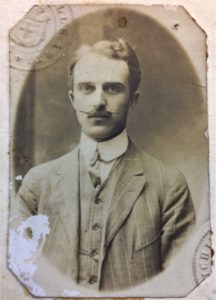
Fig 1 – Gordon Samuel Keesing, 1913
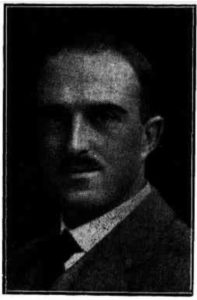
Fig 2 – Mr Gordon Keesing, 23 November, 1923 ‘The architect who designed the NSW Jewish War Memorial’, Australian Jewish Herald
Gordon Samuel Keesing was born at Auckland, May 19, 1888, the eldest child of Henry ‘Harry’ Albert and Hannah Rachel Keesing (nee: Benjamin). Nancy Keesing in Riding the Elephant confirms the Keesing family role in the establishment of the Auckland Jewish Synagogue in 1885, prior to her father’s birth.
Gordon emigrated to Australia in 1907 to pursue his passion for Architecture in Melbourne and Sydney, with subsequent years lived in Britain, Italy, America and France, undertaking architectural training in Beaux Arts. Known for his artistic skill, Keesing grasped the opportunity to travel and sketch the classical architecture and built heritage throughout Britain and Europe.
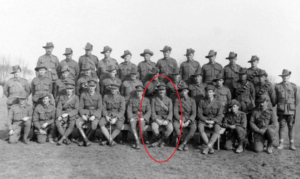
Fig 3 – Group portrait of the officers and NCOs of the 12th Field Company of Australian Engineers, Nieppe, France, March 13, 1918, AWM
From Great War subaltern field engineer to commissioned Architect for the Australian War Memorial scheme (1919)
Keesing was a practicing architect in Sydney when volunteering for active service within the Australian Imperial Forces (AIF) December 2, 1915. He received a commissioned role as 2nd Lieutenant to serve on the Western Front within the 12th Field Engineers, 4th Division. His military life and service commenced at the Engineer Officers Training School located at the Sydney Cricket Ground. On the morning prior to his deployment overseas, Keesing attended The Great Synagogue Sydney and received ‘a special blessing in English’ from the Rabbi.
After his journey from Sydney aboard HMAT Nestor A71, April 9, 1916, the month of May in Cairo, Egypt, involved ‘Camp Officer’ duties at the Intermediate Base Depot. Leaving Cairo in a cattle truck for Alexandria, the SS Briton, May 28, 1916, Keesing disembarked in England, for base camp training at Park House Camp near Salisbury, and later, a camp at Christchurch, Dorset, England, prior to his deployment to the Western Front on October 4, 1916.
The 12th Field Engineers tactical responses, strategic warfare planning, field infrastructure and signal communications were pursuant to ‘mobility, counter mobility and construction’. 4th Division engagements included the Battles of the Somme and Mouquet Farm (1916), Arras offensive, first attack Bullecourt campaign, Battle of Messines, The Third Battles of Ypres, inclusive of Menin Road, Polygon Wood and Passchendaele (1917), Battles of the Somme, Arras, Ancre, Villers-Bretonneux, Hamel, Amien and Albert. (Keesing is highlighted in group image (1918) above.)
A devoted letter writer to his parents in Auckland, correspondence forwarded during the war years obscured the harsh reality of war; this discretion reflective of Keesing’s demeanour throughout his lifetime. During service abroad, Keesing’s duties involved letter censorship, with instructional suppression of war information and operational details to avoid enemy infiltration drafted by General Sir John Monash.
The distance from homeland to those on active service was never more apparent when sad news arrived to the frontline. Keesing received notification by cable of his younger sister, Beryl’s death, 19 February 1917, and his parent’s guardianship of her only son, Lindsay (known ‘Buster’).
During his war service, Keesing from January 1917 was appointed to rank of Lieutenant, and served as Temporary Captain in 1918 in the absence of his superior. Shortly before the armistice, during service ‘in the field’, Acting Captain Keesing was transferred to the Commanding Royal Engineers AIF Unit (CRE). Throughout his war service, as part of the AIF Education and demilitarisation scheme, Keesing provided lectures in Town Planning and travel.
At the end of January 1919, Keesing received a commissioned position as Principal Australian Architect for the War Graves Unit, working as a staff member at Australia House Headquarters, London, for Allan Edward Box, ‘the official Secretary to the High Commissioner for Australia’. A letter home highlights his February 1919 ‘trip to Lille and other districts of France’ in the company of Prime Minister, Billy Hughes – crossing the English Channel, and ‘motoring in a Rolls Royce’.
Sir Douglas Haig, prominent British military leader mentioned Keesing in a dispatch of March 16, 1919, with this special mention documented in the London Gazette 31448 of July 8, 1919. This was specific to his architectural service in association with the Australian War Graves Section and IWGC (now Commonwealth War Graves Commission – CWGC). Keesing received his final military promotion and ranking of Captain.
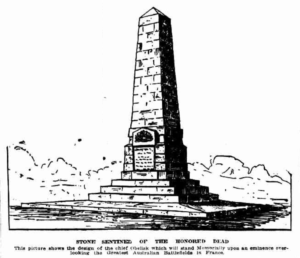
Fig 4 – Uniformed Australian Divisional Memorial preliminary design sketch
The Australian Divisional Memorials located in France and Belgium were a Commonwealth Government initiative authorised by Prime Minister Billy Hughes, organised by the Australian High Commissioner, Andrew Fisher, and his Private Secretary, Allan Edward Box, in conjunction with the Australian Battle Memorials and Soldiers’ Graves’ Committee. Erecting Australian Divisional Memorials was in response to requests from each Division and their military superiors to establish a memorial at ‘victory’ locations (known then as ‘Battle Exploit sites’) – where each division had success in their respective campaigns. The organisation of such memorials on the Western Front required much collaboration between British officials, French and Belgium governments.
In London, during the early months of 1919, Keesing prepared war monument designs for the comprehensive Australian Battle Exploit scheme. A few of these original plans were never realised due to several factors, including lack of finances post-war. During this period, he was tasked with producing two National Australian Memorials for Villers-Bretonneux and Broodseine Cross Roads, the uniformed Australian Divisional Memorials for exploit sites chosen by each Division, and plans for the conversion of a library into a memorial room at Australia House. The uniformity of obelisk design (for memorial 1,3,4,5) provided instant recognition as a distinct Australian landmark in a foreign landscape, with each location highlighting the area as a victorious AIF battle exploit site.
The various Australian Memorial Schemes final sketches and plans Keesing personally delivered to Talbot-Hobbs in Amiens, France, April 1, 1919 – travelling from London. The following day, Keesing accompanied Talbot-Hobbs and other senior military officials to Villers-Bretonneux and other battle exploit sites. Before returning to Australia, he submitted further designs on September 10, 1919, for the bronze inscription panels for Divisional Memorials 1, 3, 4, and 5.
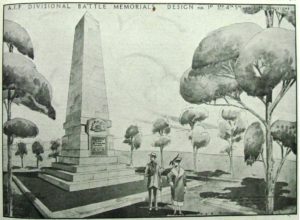
Fig 5 – Final Design for Uniformed Australian Divisional Memorials : The British- Australasian, October 16 1919
References in the lower right of the below plan highlight Keesing as designer, the preceding Belgian Engineering Architect Emile Devereux of Charleroi (employed to provide engineering plans for this design), and the Principal Supervisor of the Australian Divisional Memorials Battle Scheme, Lieutenant General Sir John J. Talbott Hobbs.
AICOMOS Australia (Australian International Council on Monuments and Sites) infers Keesing’s original 1919 plan for the Australian National Memorial, his design elements and layout for Villers Bretonneux was considered and even reinforced by British Architect, Sir Edward Lutyens, when the Imperial War Graves Commission (IWGC) were involved in its construction decades later.
From late April until June 1919, Keesing travelled to Gallipoli, as commissioned Australian Architect and representative to report on war graves in conjunction with Captain Cyril Emerson Hughes. Alongside the Principal Architect, Sir John James Burnet (appointed by the IWGC), Keesing was to contribute, collaborate, prepare artistic schemes and landscaping plans for the Australian Memorial Scheme for the Gallipoli Peninsula. Burnet and Keesing shared a common architectural background and interest in LÉcole des Beaux Arts instruction. Various memorials were designed during this period, including Helles Memorial and the Lone Pine Memorial.
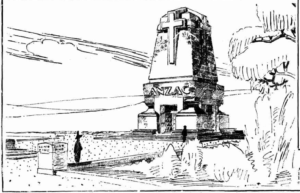
Fig 6 – Preliminary sketch of the Lone Pine Memorial, Gallipoli, Turkey – [Keesing, 1919]
War service had a deep and long-lasting effect upon Keesing. He set a demanding pace post-war to re-establish himself as a civic and suburban architect, his philanthropic endeavours, and his role in the Jewish Literary and Debating Society. Keesing offered his skills and service as Honorary Architect for the Returned Soldiers and Sailors Imperial League NSW, assisted civic committees in erecting Memorials, reported on War Service Homes for Returned Soldiers, Honorary Secretary Returned Soldier Architects, Honorary Architect for the RSPCA, and involvement in Legacy. All these acts of service are reflective of the ethos inscribed in gilt lettering above the original stage in the NSW Jewish War Memorial Hall – ‘The Path of Duty was the Way to Glory’.
Rabbi Cohen at The Great Synagogue on November 1 1922 officiated at the marriage of Margery Isabel Rahel Hart to Gordon Samuel Keesing, making their home in the Sydney suburbs of Darling Point, Pennant Hills and eventually Roseville.
During the same year as his marriage, Keesing designed the bronze memorial plaque in memory of the supreme sacrifice of NSW Jewish Soldiers, officially unveiled by Samuel Sydney Cohen in the portico of The Great Synagogue Sydney.
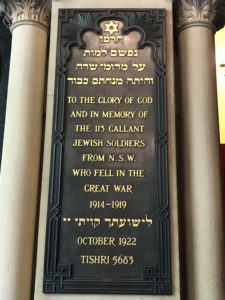
Fig 7 – NSW Jewish War Memorial Plaque – The Great Synagogue, Sydney – Image by Merril Jackson
Other notable achievements during Keesing’s lifetime included designing in 1922 the NSW Jewish War Memorial, Darlinghurst, Sydney, (formerly known Maccabean Hall – now Sydney Jewish Museum), officially opened by Lieutenant General Sir John Monash November 11, 1923, the Bondi Synagogue, 1923 (Grosvenor St, demolished 1970) and Newcastle Synagogue, 1924.
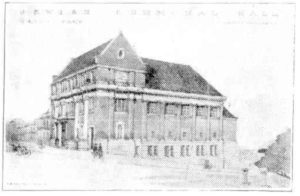
NSW Jewish War Memorial Hall – Maccabean Hall – Architect, Gordon Samuel Keesing, Image: State Library of NSW
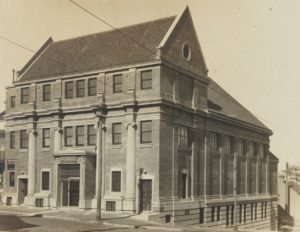
NSW Jewish War Memorial Hall – Maccabean Hall – Architect, Gordon Samuel Keesing, Image: State Library of NSW
Gordon Samuel Keesing, loved family member, esteemed architect, Life Governor and Former President of the NSW Jewish War Memorial, Honorary Life Member of the RSL, FRIBA – (Fellow) Royal Institute of British Architects, and FRAIA – (Fellow) Royal Australian Institute of Architects, died January 8, 1972.
IMAGES
Fig. 1 – Gordon Samuel Keesing (1913) ‘Personal Card for Free Admission to Museums, Antiquities Excavations and National Monuments’, Papers of Gordon Samuel Keesing, 1913-1970 [manuscript], Bib ID 2624940, National Library of Australia, Canberra, ACT
Fig. 2 – ‘MR G. KEESING, The architect who designed the NSW Jewish War Memorial’, The Australian Jewish Herald, Melbourne, Victoria, Fri 23 Nov 1923, p.18, , retrieved from Trove Newspapers, National Library of Australia, Canberra, https://trove.nla.gov.au/newspaper/article/261017294
Fig. 3 – Australian War Memorial, E01978 ‘Group portrait of the officers and NCOs of the 12th Field Company of Australian Engineers’, retrieved online: https://www.awm.gov.au/collection/E01978
Fig. 4 – ‘A.I.F. Memorials: QUESTION OF FREEHOLD AFFECTS FRENCH SITES A Pantheon Projected’, The Herald, Saturday 26 July 1919, p.7, retrieved online: https://trove.nla.gov.au/newspaper/article/242590520
Fig. 5 –Final Design for Uniformed Australian Divisional Memorials : The British- Australasian, October 16 1919, p.15.
Fig. 6 – Uniformed Australian Divisional Memorial preliminary design sketch: ‘Our Noble Dead: Memorials in Gallipoli and France’, Sydney Mail, Wednesday 24 December 1919, page 14, retrieved online: https://trove.nla.gov.au/newspaper/article/159654977
Fig. 7 – NSW Jewish War Memorial Plaque – The Great Synagogue, Sydney – Image by Merril Jackson
Fig. 8 – NSW Jewish War Memorial Hall – Maccabean Hall – Architect, Gordon Samuel Keesing, Image: State Library of NSW, Call # PXD 655/22-26, retrieved online: https://www.sl.nsw.gov.au/stories/australian-jewish-community-and-culture/nsw-war-memorial
REFERENCES
Abrahams, Hector, Darren Mitchell and Meg Quinlisk, The Other Gallipoli: The Australian National Memorial at Villers-Bretonneux, France, Fabric: Threads of Conservation, Australia ICOMOS Conference, Adelaide, 2015, p.6.
Attestation Papers 1915-1920 : B2455, KEESING GORDON SAMUEL – ‘(Service and Casualty Form Part II)’, National Archive of Australia, Canberra, ACT, p.27, retrieved online: https://recordsearch.naa.gov.au/SearchNRetrieve/Interface/ViewImage.aspx?B=7367157
‘Australian Imperial Force: Engineers – Keesing, Lt. G.S. Keesing, 12th Fd. Coy.’, Supplement to the London Gazette, 11 July, 1919, p.8829, retrieved online: http://www.thomsonfielddiary.ca/pdfs/London%20Gazette%2031448%20(MiD).pdf
Box, E. A. Official Secretary, Commonwealth of Australia, Australia House, Strand, London, Correspondence 30th April 1919, ‘Proposed National Australian Memorial, Broodseinde Ridge; Proposed A.I.F. Memorial near Villers Bretonneux- Australian National Monument, Commonwealth War Graves Commission Document File, CWGC Head Office, Maidenhead, UK.
Editorial, ‘Wedding’, Hebrew Standard of Australasia, Friday 27 October 1922, p.10, Trove Newspapers, National Library of Australia, Canberra, retrieved https://trove.nla.gov.au/newspaper/article/120611843 , February 12, 2021.
Keesing, Gordon Samuel, Personal letter home to parents : undated June 1916, Papers of Gordon Samuel Keesing, 1913-1970 [manuscript], Bib ID 2624940, National Library of Australia, Canberra, ACT.
Keesing, Gordon Samuel, Personal letter home to parents : dated 9th April 1916, Papers of Gordon Samuel Keesing, 1913-1970 [manuscript], Bib ID 2624940, National Library of Australia, Canberra, ACT.
Keesing, Gordon Samuel, Personal letter home to parents : dated June 1918, Papers of Gordon Samuel Keesing, 1913-1970 [manuscript], Bib ID 2624940, National Library of Australia, Canberra, ACT.
Keesing, Gordon Samuel, Personal letter home to parents : dated 6/3/19, Papers of Gordon Samuel Keesing, 1913-1970 [manuscript], Bib ID 2624940, National Library of Australia, Canberra, ACT.
Keesing, Gordon Samuel ‘Specification for Bronze Inscription Plates and Rising Sun Badges for Australian Divisional Memorials in France and Belgium: Architect: Capt. G. S. Keesing, Australia House, Strand, LONDON – Contract Original’, NAA: A2909, AGS6/1/6 PART3, National Archives in Australia, Canberra.
Keesing, Nancy ‘Riding the Elephant’, Allen and Unwin, Sydney, 1988, p.13.
Monash, General Sir John ‘Instructions on censorship issued by Monash to the Censor, 22 August 1914’, retrieved from: Personal Files Book 1, 14 August -3 November 1914, Australian War Memorial, Canberra.
N.S.W. Jewish War Memorial Foundation Stone of Sydney Communal Hall. A Historic Ceremony., Australian Jewish Chronicle, Thursday 8 March 1923, p.6, retrieved online: https://trove.nla.gov.au/newspaper/article/260891939
‘N.S.W. Jewish War Memorial Plaque Unveiled at the Great Synagogue’, Hebrew Standard of Australasia, Friday 10 November 1922, p.11, Trove Newspapers, Retrieved online: https://trove.nla.gov.au/newspaper/article/120614445
Talbot Hobbs, Sir John James, ‘Major General J. Talbot Hobbs – 5th Aust. Div. Private Diary Nov 1918 Vol. V, Army Book 136.: Vol.5 Nov. 1918 to July 1919’, State Library of Western Australia, retrieved online: https://purl.slwa.wa.gov.au/slwa_b3937592_5
‘12th Field Company Engineers, 4th Division AIF, Virtual War Memorial Australia, undated, retrieved from: https://vwma.org.au/explore/units/185
Written (with photographs) by Merril Jackson OAM (ADLFAH, BHIP) on behalf of grandchildren of Gordon Samuel Keesing, Margery Hertzberg and Brian Oldenburg.